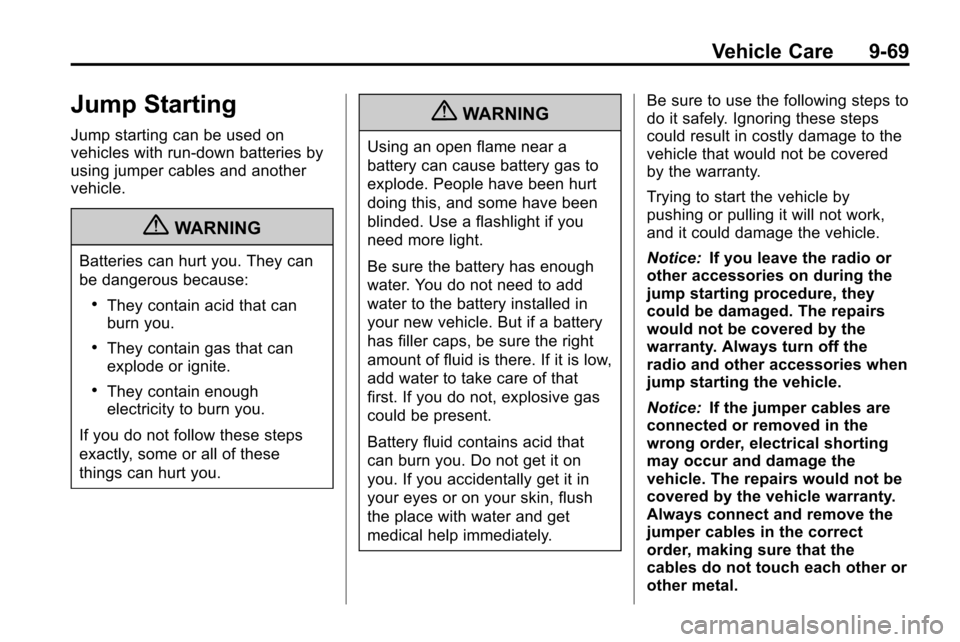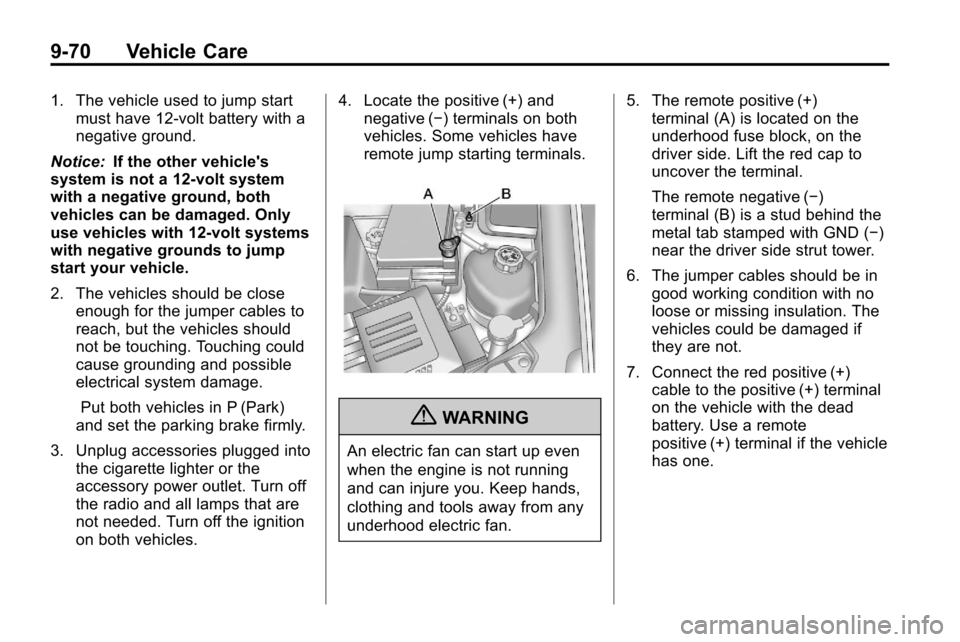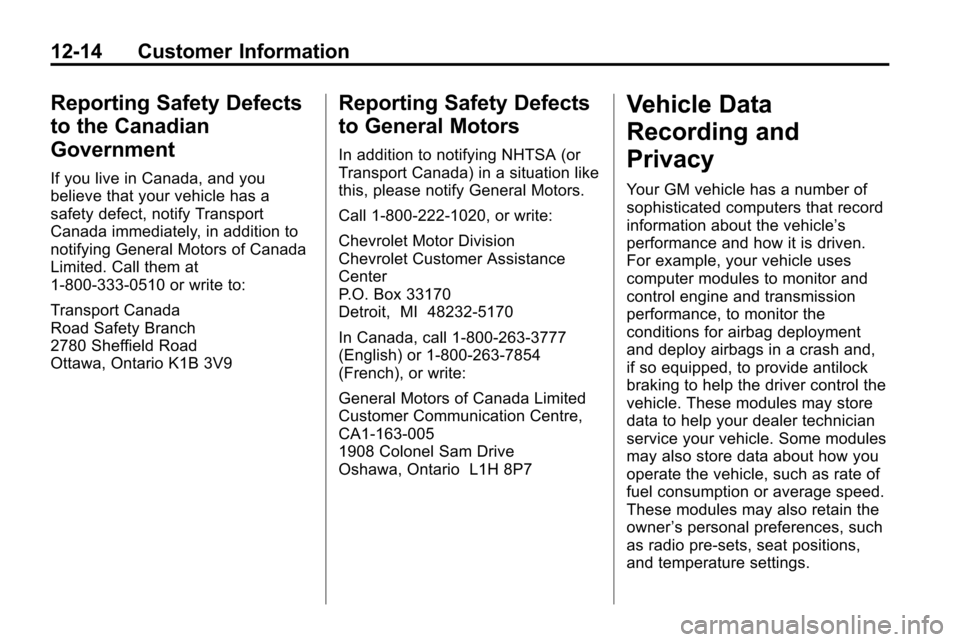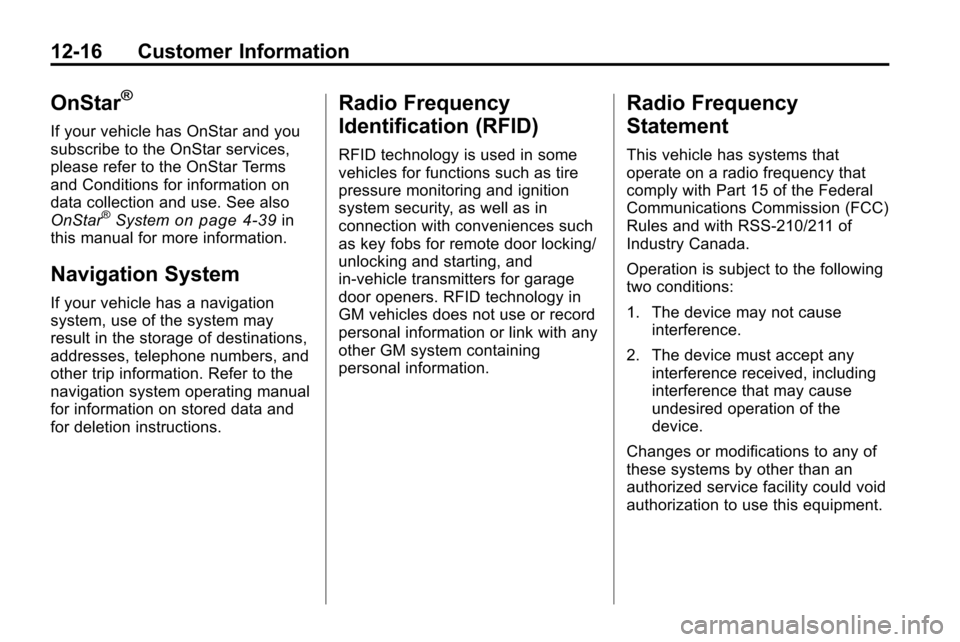2010 CHEVROLET EQUINOX radio
[x] Cancel search: radioPage 318 of 394

9-50 Vehicle Care
TPMS Malfunction Light and
Message
The TPMS will not function properly
if one or more of the TPMS sensors
are missing or inoperable. When the
system detects a malfunction, the
low tire warning light flashes for
about one minute and then stays on
for the remainder of the ignition
cycle. A DIC warning message is
also displayed. The low tire warning
light and DIC warning message
come on at each ignition cycle until
the problem is corrected. Some of
the conditions that can cause the
malfunction light and DIC message
to come on are:
.One of the road tires has been
replaced with the spare tire. The
spare tire does not have a
TPMS sensor. The TPMS
malfunction light and DIC
message should go off once you
re‐install the road tire containing
the TPMS sensor.
.The TPMS sensor matching
process was started but not
completed or not completed
successfully after rotating the
vehicle's tires. The DIC message
and TPMS malfunction light
should go off once the TPMS
sensor matching process is
performed successfully. See
“TPMS Sensor Matching
Process”later in this section.
.One or more TPMS sensors are
missing or damaged. The DIC
message and the TPMS
malfunction light should go off
when the TPMS sensors are
installed and the sensor
matching process is performed
successfully. See your dealer for
service.
.Replacement tires or wheels do
not match your vehicle's original
equipment tires or wheels. Tires
and wheels other than those
recommended for your vehicle
could prevent the TPMS from
functioning properly. See Buying
New Tires on page 9‑54.
.Operating electronic devices or
being near facilities using radio
wave frequencies similar to the
TPMS could cause the TPMS
sensors to malfunction.
If the TPMS is not functioning it
cannot detect or signal a low tire
condition. See your dealer for
service if the TPMS malfunction
light and DIC message comes on
and stays on.
TPMS Sensor Matching
Process
Each TPMS sensor has a unique
identification code. Any time you
rotate your vehicle's tires or replace
one or more of the TPMS sensors,
the identification codes will need to
be matched to the new tire/wheel
position. The sensors are matched
to the tire/wheel positions in the
following order: driver side front tire,
passenger side front tire, passenger
side rear tire, and driver side rear
tire using a TPMS diagnostic tool.
See your dealer for service.
Page 337 of 394

Vehicle Care 9-69
Jump Starting
Jump starting can be used on
vehicles with run‐down batteries by
using jumper cables and another
vehicle.
{WARNING
Batteries can hurt you. They can
be dangerous because:
.They contain acid that can
burn you.
.They contain gas that can
explode or ignite.
.They contain enough
electricity to burn you.
If you do not follow these steps
exactly, some or all of these
things can hurt you.
{WARNING
Using an open flame near a
battery can cause battery gas to
explode. People have been hurt
doing this, and some have been
blinded. Use a flashlight if you
need more light.
Be sure the battery has enough
water. You do not need to add
water to the battery installed in
your new vehicle. But if a battery
has filler caps, be sure the right
amount of fluid is there. If it is low,
add water to take care of that
first. If you do not, explosive gas
could be present.
Battery fluid contains acid that
can burn you. Do not get it on
you. If you accidentally get it in
your eyes or on your skin, flush
the place with water and get
medical help immediately. Be sure to use the following steps to
do it safely. Ignoring these steps
could result in costly damage to the
vehicle that would not be covered
by the warranty.
Trying to start the vehicle by
pushing or pulling it will not work,
and it could damage the vehicle.
Notice:
If you leave the radio or
other accessories on during the
jump starting procedure, they
could be damaged. The repairs
would not be covered by the
warranty. Always turn off the
radio and other accessories when
jump starting the vehicle.
Notice: If the jumper cables are
connected or removed in the
wrong order, electrical shorting
may occur and damage the
vehicle. The repairs would not be
covered by the vehicle warranty.
Always connect and remove the
jumper cables in the correct
order, making sure that the
cables do not touch each other or
other metal.
Page 338 of 394

9-70 Vehicle Care
1. The vehicle used to jump startmust have 12-volt battery with a
negative ground.
Notice: If the other vehicle's
system is not a 12-volt system
with a negative ground, both
vehicles can be damaged. Only
use vehicles with 12-volt systems
with negative grounds to jump
start your vehicle.
2. The vehicles should be close enough for the jumper cables to
reach, but the vehicles should
not be touching. Touching could
cause grounding and possible
electrical system damage.
Put both vehicles in P (Park)
and set the parking brake firmly.
3. Unplug accessories plugged into the cigarette lighter or the
accessory power outlet. Turn off
the radio and all lamps that are
not needed. Turn off the ignition
on both vehicles. 4. Locate the positive (+) and
negative (−) terminals on both
vehicles. Some vehicles have
remote jump starting terminals.
{WARNING
An electric fan can start up even
when the engine is not running
and can injure you. Keep hands,
clothing and tools away from any
underhood electric fan. 5. The remote positive (+)
terminal (A) is located on the
underhood fuse block, on the
driver side. Lift the red cap to
uncover the terminal.
The remote negative (−)
terminal (B) is a stud behind the
metal tab stamped with GND (−)
near the driver side strut tower.
6. The jumper cables should be in good working condition with no
loose or missing insulation. The
vehicles could be damaged if
they are not.
7. Connect the red positive (+) cable to the positive (+) terminal
on the vehicle with the dead
battery. Use a remote
positive (+) terminal if the vehicle
has one.
Page 367 of 394

Customer Information 12-1
Customer
Information
Customer Information
Customer SatisfactionProcedure . . . . . . . . . . . . . . . . . . 12-1
Customer Assistance Offices . . . . . . . . . . . . . . . . . . . . . 12-3
Customer Assistance for Text Telephone (TTY) Users . . . . . 12-4
Online Owner Center . . . . . . . . 12-4
GM Mobility Reimbursement Program . . . . . . . . . . . . . . . . . . . . 12-5
Roadside Assistance Program . . . . . . . . . . . . . . . . . . . . 12-6
Scheduling Service Appointments . . . . . . . . . . . . . . 12-8
Courtesy Transportation Program . . . . . . . . . . . . . . . . . . . . 12-8
Collision Damage Repair . . . 12-10
Service Publications Ordering Information . . . . . . 12-12
Reporting Safety Defects
Reporting Safety Defects tothe United States
Government . . . . . . . . . . . . . . . 12-13
Reporting Safety Defects to the Canadian
Government . . . . . . . . . . . . . . . 12-14
Reporting Safety Defects to General Motors . . . . . . . . . . . 12-14
Vehicle Data Recording and
Privacy
Vehicle Data Recording andPrivacy . . . . . . . . . . . . . . . . . . . . 12-14
Event Data Recorders . . . . . . 12-15
OnStar
®. . . . . . . . . . . . . . . . . . . . 12-16
Navigation System . . . . . . . . . 12-16
Radio Frequency Identification (RFID) . . . . . . . 12-16
Radio Frequency Statement . . . . . . . . . . . . . . . . . 12-16
Customer Information
Customer Satisfaction
Procedure
Your satisfaction and goodwill are
important to your dealer and to
Chevrolet. Normally, any concerns
with the sales transaction or the
operation of the vehicle will be
resolved by the dealer's sales or
service departments. Sometimes,
however, despite the best intentions
of all concerned, misunderstandings
can occur. If your concern has not
been resolved to your satisfaction,
the following steps should be taken:
STEP ONE: Discuss your concern
with a member of dealership
management. Normally, concerns
can be quickly resolved at that level.
If the matter has already been
reviewed with the sales, service,
or parts manager, contact the owner
of the dealership or the general
manager.
Page 380 of 394

12-14 Customer Information
Reporting Safety Defects
to the Canadian
Government
If you live in Canada, and you
believe that your vehicle has a
safety defect, notify Transport
Canada immediately, in addition to
notifying General Motors of Canada
Limited. Call them at
1-800-333-0510 or write to:
Transport Canada
Road Safety Branch
2780 Sheffield Road
Ottawa, Ontario K1B 3V9
Reporting Safety Defects
to General Motors
In addition to notifying NHTSA (or
Transport Canada) in a situation like
this, please notify General Motors.
Call 1-800-222-1020, or write:
Chevrolet Motor Division
Chevrolet Customer Assistance
Center
P.O. Box 33170
Detroit, MI 48232-5170
In Canada, call 1-800-263-3777
(English) or 1-800-263-7854
(French), or write:
General Motors of Canada Limited
Customer Communication Centre,
CA1-163-005
1908 Colonel Sam Drive
Oshawa, Ontario L1H 8P7
Vehicle Data
Recording and
Privacy
Your GM vehicle has a number of
sophisticated computers that record
information about the vehicle’s
performance and how it is driven.
For example, your vehicle uses
computer modules to monitor and
control engine and transmission
performance, to monitor the
conditions for airbag deployment
and deploy airbags in a crash and,
if so equipped, to provide antilock
braking to help the driver control the
vehicle. These modules may store
data to help your dealer technician
service your vehicle. Some modules
may also store data about how you
operate the vehicle, such as rate of
fuel consumption or average speed.
These modules may also retain the
owner’s personal preferences, such
as radio pre-sets, seat positions,
and temperature settings.
Page 382 of 394

12-16 Customer Information
OnStar®
If your vehicle has OnStar and you
subscribe to the OnStar services,
please refer to the OnStar Terms
and Conditions for information on
data collection and use. See also
OnStar
®Systemon page 4‑39in
this manual for more information.
Navigation System
If your vehicle has a navigation
system, use of the system may
result in the storage of destinations,
addresses, telephone numbers, and
other trip information. Refer to the
navigation system operating manual
for information on stored data and
for deletion instructions.
Radio Frequency
Identification (RFID)
RFID technology is used in some
vehicles for functions such as tire
pressure monitoring and ignition
system security, as well as in
connection with conveniences such
as key fobs for remote door locking/
unlocking and starting, and
in-vehicle transmitters for garage
door openers. RFID technology in
GM vehicles does not use or record
personal information or link with any
other GM system containing
personal information.
Radio Frequency
Statement
This vehicle has systems that
operate on a radio frequency that
comply with Part 15 of the Federal
Communications Commission (FCC)
Rules and with RSS-210/211 of
Industry Canada.
Operation is subject to the following
two conditions:
1. The device may not cause interference.
2. The device must accept any interference received, including
interference that may cause
undesired operation of the
device.
Changes or modifications to any of
these systems by other than an
authorized service facility could void
authorization to use this equipment.
Page 383 of 394

INDEX i-1
A
Accessories andModifications . . . . . . . . . . . . . . . . . . 9-4
Accessory Power . . . . . . . . . . . . . . 8-29
Add-On Electrical Equipment . . . . . . . . . . . . . . . . . . . 8-64
Adding Equipment to the
Airbag-Equipped Vehicle . . . . . 2-35
Adjustments Lumbar, Front Seats . . . . . . . . . . . 2-5
Air Cleaner/Filter, Engine . . . . . . 9-13
Air Filter, Passenger
Compartment . . . . . . . . . . . . . . . . . 7-6
Air Vents . . . . . . . . . . . . . . . . . . . . . . . 7-6
Airbag System Check . . . . . . . . . . . . . . . . . . . . . . . . 2-36
How Does an Airbag
Restrain? . . . . . . . . . . . . . . . . . . . 2-28
Passenger Sensing System . . . . . . . . . . . . . . . . . . . . . . 2-30
What Makes an Airbag Inflate? . . . . . . . . . . . . . . . . . . . . . . 2-28 Airbag System (cont.)
What Will You See After
an Airbag Inflates? . . . . . . . . . . 2-28
When Should an Airbag
Inflate? . . . . . . . . . . . . . . . . . . . . . . 2-26
Where Are the Airbags? . . . . . . 2-25
Airbags Adding Equipment to theVehicle . . . . . . . . . . . . . . . . . . . . . . 2-35
Passenger Status Indicator . . . 4-15
Readiness Light . . . . . . . . . . . . . . 4-15
Servicing Airbag-Equipped Vehicles . . . . . . . . . . . . . . . . . . . . . 2-34
System Check . . . . . . . . . . . . . . . . 2-22
Alarm System Anti-Theft . . . . . . . . . . . . . . . . . . . . . 1-12
All-Wheel Drive . . . . . . . . . . 8-38, 9-24
AM-FM Radio . . . . . . . . . . . . . . . . . . 6-11
Antenna Multi-Band . . . . . . . . . . . . . . . . . . . . 6-18
Anti-Theft Alarm System . . . . . . . . . . . . . . . . 1-12
Alarm System Messages . . . . . 4-32 Antilock Brake
System (ABS) . . . . . . . . . . . . . . . . 8-38
Warning Light . . . . . . . . . . . . . . . . . 4-20
Appearance Care Exterior . . . . . . . . . . . . . . . . . . . . . . . 9-75
Interior . . . . . . . . . . . . . . . . . . . . . . . . 9-79
Assistance Program,
Roadside . . . . . . . . . . . . . . . . . . . . . 12-6
Audio Players . . . . . . . . . . . . . . . . . 6-19 CD . . . . . . . . . . . . . . . . . . . . . . . . . . . 6-19
Audio System
Radio Reception . . . . . . . . . . . . . . 6-18
Theft-Deterrent Feature . . . . . . . . 6-2
Automatic Climate Control System . . . . . . . . . . . . . . . . . . . . . . . . 7-3
Automatic Transmission . . . . . . . 8-35
Fluid . . . . . . . . . . . . . . . . . . . . . . . . . . 9-12
Manual Mode . . . . . . . . . . . . . . . . . 8-37
Shiftlock Control SystemCheck . . . . . . . . . . . . . . . . . . . . . . . 9-25
Auxiliary Devices . . . . . . . . 6-28, 6-31
Page 390 of 394

i-8 INDEX
Operation, InfotainmentSystem . . . . . . . . . . . . . . . . . . . . . . . . 6-7
Outlets Power . . . . . . . . . . . . . . . . . . . . . . . . 4-10
Overheating, Engine . . . . . . . . . . . 9-18
Overview Instrument Panel . . . . . . . . . . . . . . 4-4
Overview, Infotainment System . . . . . . . . . . . . . . . . . . . . 6-3, 6-5
P
ParkShifting Into . . . . . . . . . . . . . . . . . . . 8-32
Shifting Out of . . . . . . . . . . . . . . . . 8-33
Park Tilt Mirrors . . . . . . . . . . . . . . . . 1-15
Parking Assist, Ultrasonic . . . . . . . . . . . . . 8-46
Brake . . . . . . . . . . . . . . . . . . . . . . . . . 8-40
Brake and P (Park)Mechanism Check . . . . . . . . . . 9-26
Over Things That Burn . . . . . . . 8-33
Passenger Airbag Status Indicator . . . . . . . . . . . . . . . . . . . . . 4-15
Passenger Compartment Air Filter . . . . . . . . . . . . . . . . . . . . . . . . . . 7-6 Passenger Sensing System . . . 2-30
Perchlorate Materials
Requirements, California . . . . . . 9-3
Phone Bluetooth . . . . . . . 6-42, 6-43, 6-46, 6-58
Power
Door Locks . . . . . . . . . . . . . . . . . . . . 1-7
Mirrors . . . . . . . . . . . . . . . . . . . . . . . . 1-14
Outlets . . . . . . . . . . . . . . . . . . . . . . . 4-10
Retained Accessory (RAP) . . . 8-29
Seat Adjustment . . . . . . . . . . . . . . . 2-3
Steering Fluid . . . . . . . . . . . . . . . . . 9-20
Windows . . . . . . . . . . . . . . . . . . . . . 1-16
Pregnancy, Using Safety Belts . . . . . . . . . . . . . . . . . . . . . . . . . 2-21
Privacy Radio Frequency
Identification (RFID) . . . . . . . 12-16
Program Courtesy Transportation . . . . . . 12-8
Proposition 65 Warning, California . . . . . . . . . . . . . . . . . . . . . . 9-3
R
Radio Frequency
Identification (RFID) . . . . . . . . 12-16
Statement . . . . . . . . . . . . . . . . . . 12-16
Radios AM-FM Radio . . . . . . . . . . . . . . . . . 6-11
CD/DVD Player . . . . . . . . . . . . . . . 6-21
Reception . . . . . . . . . . . . . . . . . . . . 6-18
Satellite . . . . . . . . . . . . . . . . . . . . . . . 6-14
Reading Lamps . . . . . . . . . . . . . . . . . 5-4
Rear Seat Entertainment System . . . . . . . . . . . . . . . . . . . . . . . 6-33
Rear Seats . . . . . . . . . . . . . . . . . . . . . 2-8
Rear Vision Camera (RVC) . . . . 8-49
Rear Window Washer/Wiper . . . . 4-8
Rearview Mirrors . . . . . . . . . . . . . . 1-15 Automatic Dimming . . . . . . . . . . . 1-15
Reclining Seatbacks . . . . . . . . . . . . 2-5
Recommended Fluids and Lubricants . . . . . . . . . . . . . . . . . . . . 10-7
Recommended Fuel . . . . . . . . . . . 8-54
Records Maintenance . . . . . . . . . . . . . . . . 10-10